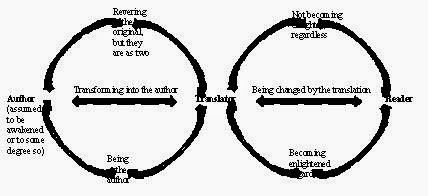The Dynamic Possibilities Theory
One Possibility
As a result of pondering sacred text translation discourses east and west, four aspects of Buddhist philosophical views of language and texts, I have developed one possible theory for the translation of Buddhist sacred texts from Chinese to English. I balance American Bible Society theorist Eugene Nida’s dynamic equivalence theory on the target side plus Buddhist intentionality and continued dialogic with the interlocutor of the sacred text on the author side — if we have to name sides in what I mean to be cycles as seen in the diagram below. To elucidate too, “intentionality” as Buddhist scholar Masao Abe identifies it, is “not so much a textual question as it was — and more properly is — a human and existential one.” He insists that the capacity for deep interlocution is in the Buddhist sacred texts long after the death of the author or orator.
Ground this equation in ancient Buddhist translation models, including the determination to evolve spiritually, the divide morphs among participants, languages, texts, contexts, motives, and understanding with each additional dynamic interaction.
The following is my published illustration in Translating Totality in Parts: Chengguan’s Commentaries and Subcommentaries to the Avatamsaka Sutra. This two-dimensional diagram is meant to resemble an infinity symbol where each member along the translation spectrum is so intimately connected to the others that there is no reified one or the other.
|
|
|
|
|
|
